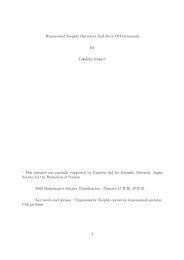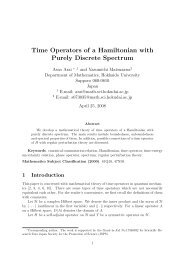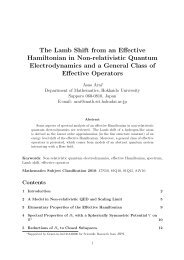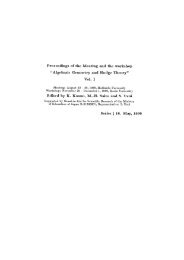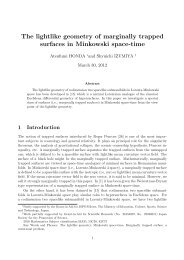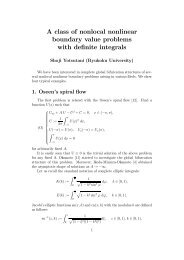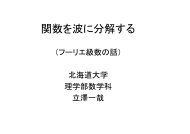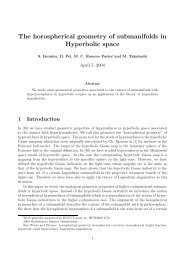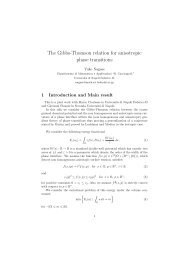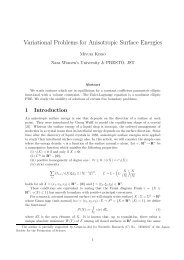Contact Geometry of second order I - Dept. Math, Hokkaido Univ ...
Contact Geometry of second order I - Dept. Math, Hokkaido Univ ...
Contact Geometry of second order I - Dept. Math, Hokkaido Univ ...
Create successful ePaper yourself
Turn your PDF publications into a flip-book with our unique Google optimized e-Paper software.
The third case occurs when we classify over R. Here f is <strong>of</strong> rank 1, rank 2 (indefinite)<br />
and rank 2 (definite) respectively.<br />
(2) codim f = 2<br />
In this case dim f = 1. Hence, similarly as above, we have the following classificasion<br />
into three cases, i.e., there exists a basis <strong>of</strong> V such that<br />
⎧<br />
⎪⎨ 〈{e<br />
f =<br />
⎪⎩<br />
∗ 2 ⊚ e∗ 2}〉,<br />
〈{e∗ 1 ⊚ e∗ 2}〉,<br />
(〈{e∗ 1 ⊚ e∗ 1 + e∗ 2 ⊚ e∗ 2}〉),<br />
Thus, dually, we have<br />
f ⊥ ⎧<br />
⎪⎨ 〈{e1 ⊚ e1, e1 ⊚ e2}〉,<br />
= 〈{e1 ⊚ e1, e2 ⊚ e2}〉,<br />
⎪⎩<br />
(〈{e1 ⊚ e2, e1 ⊚ e1 − e2 ⊚ e2}〉)<br />
The third case occurs when we classify over R. We note here that, for the prolongation<br />
f (1) = f ⊗ V ∗ ∩ S 3 (V ∗ ), we have (f (1) ) ⊥ = 〈{e1 ⊚ e1 ⊚ e1, e1 ⊚ e1 ⊚ e2, e1 ⊚<br />
e2 ⊚ e2, e2 ⊚ e2 ⊚ e2}〉 for the <strong>second</strong> and third cases (see §3.3). Namely f (1) = {0}<br />
for the <strong>second</strong> and third cases, whereas the first case is involutive.<br />
We can classify the symbol algebra s(v) <strong>of</strong> R at v ∈ R according to the above classification<br />
for f(v) ⊂ S 2 (V ∗ ) under the condition (C). In the case codim R = 1, R is called<br />
parabolic, hyperbolic and elliptic at v according as f is <strong>of</strong> rank 1, rank 2 (indefinite)<br />
and rank 2 (definite) respectively, where f is a generator <strong>of</strong> (f(v)) ⊥ ⊂ S 2 (V ) (see §3.3).<br />
Now we assume the regularity for the symbol algebras. Namely assume that symbol<br />
algebras s(v) <strong>of</strong> R are locally isomorphic to the fixed symbol s = s−3 ⊕ s−2 ⊕ s−1 where<br />
s−3 = R, s−2 = V ∗ and s−1 = V ⊕ f for the fixed f ⊂ S 2 (V ∗ ). Then, for example, the<br />
Structure Equation reads as follows:<br />
(i) f⊥ = 〈{e1 ⊚ e2}〉<br />
⎧<br />
⎪⎨<br />
dϖ ≡ ω1 ∧ ϖ1 + ω2 ∧ ϖ2 (mod ϖ)<br />
dϖ1 ≡ ω1 ∧ π11<br />
⎪⎩<br />
dϖ2 ≡ ω2 ∧ π22<br />
(mod<br />
(mod<br />
ϖ, ϖ1, ϖ2)<br />
ϖ, ϖ1, ϖ2)<br />
(ii) f⊥ = 〈{e1 ⊚ e1, e1 ⊚ e2}〉<br />
⎧<br />
⎪⎨<br />
dϖ ≡ ω1 ∧ ϖ1 + ω2 ∧ ϖ2 (mod ϖ)<br />
dϖ1 ≡<br />
⎪⎩<br />
dϖ2 ≡<br />
0<br />
ω2 ∧ π22<br />
(mod<br />
(mod<br />
ϖ, ϖ1, ϖ2)<br />
ϖ, ϖ1, ϖ2)<br />
(iii) f⊥ = 〈{e1 ⊚ e1, e2 ⊚ e2}〉<br />
⎧<br />
⎪⎨<br />
dϖ ≡ ω1 ∧ ϖ1 + ω2 ∧ ϖ2 (mod ϖ)<br />
dϖ1 ≡ ω2 ∧ π12<br />
⎪⎩<br />
dϖ2 ≡ ω1 ∧ π21<br />
(mod<br />
(mod<br />
ϖ, ϖ1, ϖ2)<br />
ϖ, ϖ1, ϖ2)<br />
Thus we see, from (ii), that R admitts a 1-dimensional Cauchy characteristic system in<br />
case f ⊥ = 〈{e1 ⊚ e1, e1 ⊚ e2}〉, i.e, in case R is <strong>of</strong> codimension 2 and f is involutive. In fact,<br />
in [C1], E.Cartan characterized overdetermined involutive system R by the condition that<br />
R admitts a 1-dimensional Cauchy characteristic system.<br />
9



